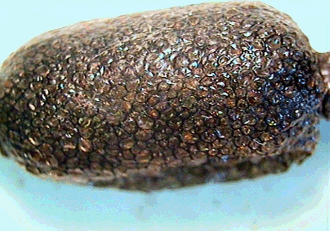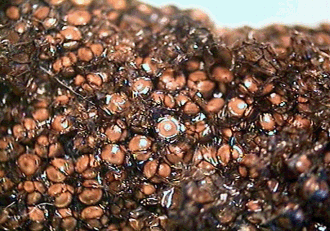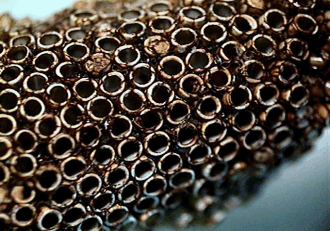Checking Eastern Tent Caterpillar Egg Masses
ENTFACT-449: Checking Eastern Tent Caterpillar Egg Masses | Download PDF
by Lee Townsend, Extension Entomologist
University of Kentucky College of Agriculture
Eastern tent caterpillars spend the winter as ring-like masses of eggs that were laid last June on twigs of wild cherry, crabapples, and related trees. It is possible to check trees for masses now to get some idea on the potential caterpillar population this spring. If large numbers are easily found, then it is obvious that managers must be ready to deal with the caterpillars after egg hatch. If few or no masses are found, it will still be important to watch those trees for tents in late March and early April.
“Spent” egg masses from which caterpillars emerged last year may be present so it is important to be able to distinguish between new and old ones. This is not hard and the pictures below will show you how. A hand magnifying lens and a sharp-tipped needle will be useful in checking masses that you find. Most all new (and some old egg masses) should be within 15 to 18 inches of the tip of twigs that are about one-quarter inch in diameter. There does not seem to be a height preference so masses can be anywhere up and down the height of the tree.
New Masses
Individual tent caterpillar eggs in “live” masses (those laid during the summer of 2002) are white but the entire mass is covered partly to entirely with a shiny, varnish-like material called spumaline (Fig. 1).

(Fig. 1) New egg mass with spumaline covering.
New egg masses will be made up of eggs with intact white tops (Fig. 2). You may want to scratch some of the spumaline away so that you can see the ends of the eggs to confirm whether they are new or old.

(Fig. 2) Spumaline removed to show white tops of eggs.
Old Masses
Most old ETC masses that hatched the previous spring will have weathered and fallen from the trees by the next season, but some will still be present. Old masses will not have much, if any, of the hard covering and the individual eggs in the mass will have a definite hole in the top. You may find old masses in which a few eggs did not hatch for some reason. They will not hatch this year.

(Fig. 3) Old egg mass.
How to Use the Information
Tree checks now would allow you to get some idea if many masses are present or that they are relatively scarce. If lots of new masses are present, then these are high priority areas that should be checked for tents as egg hatch progresses in the spring. There is nothing that can be done at this point to kill egg masses and caterpillars, short of physically removing them individually. Control measures, such as tent destruction or removal, sprays, injections, etc., need to be done after egg hatch in March.
Finding egg masses when numbers are low, just a few per tree, is like a search for a needle in a haystack. Lots of time can be spent with no obvious return and small numbers of tents may be present. General indications from the tree checks made by UK entomology personnel point to a reduced population for 2003 but numbers can vary greatly from one location to another.
Issued: 1/03
Revised: 7/19
CAUTION! Pesticide recommendations in this publication are registered for use in Kentucky, USA ONLY! The use of some products may not be legal in your state or country. Please check with your local county agent or regulatory official before using any pesticide mentioned in this publication.
Of course, ALWAYS READ AND FOLLOW LABEL DIRECTIONS FOR SAFE USE OF ANY PESTICIDE!
Images: University of Kentucky Entomology
